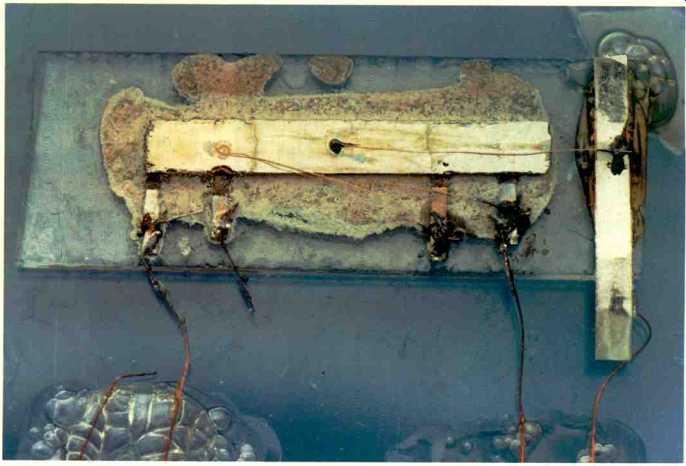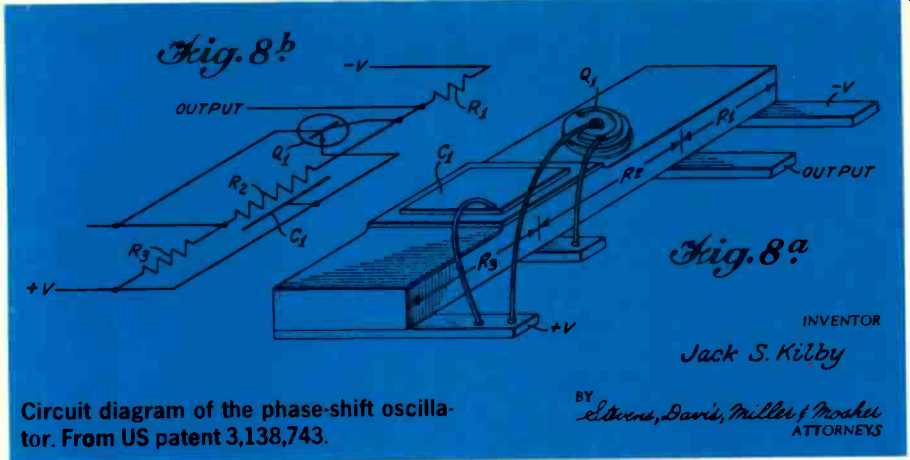12. Jack St Clair Kay (born 1923): inventor of the integrated circuit.
By W.A. ATHERTON

Above: one of Kilby's first integrated circuits, a germanium phase-shift oscillator
completed on September 12, 1958. For its circuit diagram, see below.


Above: Jack Kilby. Both photographs by courtesy of Texas Instruments.
Do you know anyone who was born on September 12, 1958? Tell them they were born on the day the electronics revolution began. It was on that day that the first integrated circuit was completed. But do not say silicon chip, for it happened to be made of germanium.
Jack Kilby's name is not well known, not even amongst electronics engineers. There are no famous television dramas of his invention. No multi national companies bear his name. A hundred years ago he would have been feted, famous and worth a fortune.
Instead this quiet, unobtrusive 'nice guy' is simply happy to work on.
Jack Kilby conceived the idea of the integrated circuit soon after he joined Texas Instruments, a youthful semiconductor manufacturer that was achieving consider able success in the late 1950s.
For eleven years he had worked at a company in Milwaukee called Centralab, a division of Globe Union, having joined them after graduating from the University of Illinois with a degree in electrical engineering. His work had taken him into the field of transistor manufacture and had introduced him to the increasingly desperate search for a solution to the major problem then facing electronics- the tyranny of numbers.
Towards the end of the 1940s, as electronic systems grew in importance and size, the number of components within them threatened to impose a limit on their size and complexity. As systems became larger more power was consumed. The weight increased and costs increased. But more components and more soldered joints meant that the reliability fell. It looked as though a limit was in sight.
After the war came the Cold War and then the space race. Both brought demands for cheaper, smaller and more reliable electronic systems.
During the war, the US had examined silk-screen printing of conductive inks to print passive components on to ceramic bases for an army proximity fuse. Later, Centralab turned the technology to peaceful uses by printing components for hearing aids and radio and television parts. It was there that Jack Kilby learned to put, simultaneously, several passive components on a single substrate. It was an important lesson for the man who would one day revolutionize electronics.
THE TRANSISTOR ARRIVES
The first revolution, though, arrived when Bell Laboratories announced the invention of the transistor. When seminars were offered to licensees to explain how to make the new devices, Centralab sent Kilby along.
It was 1952. On his return he started to make transistors. The same year, G.W.A. Dummer of the then Royal Radar Establishment at Malvern, foresaw "electronic equipment in a solid block with no connecting wires". Within the block, he predicted, would be insulating, conducting, rectifying and amplifying materials connected directly. The next year Harwick Johnson of RCA in America filed the first patent for an integrated circuit, a phase-shift oscillator. As yet no-one could make it.
After six years with transistors at Centra lab, Kilby was feeling the limitations of being on the fringe of developments. Others were succeeding with expensive diffused transistors which were better than the easier-to-make alloyed variety. Texas Instruments had announced the first commercial silicon transistors and now led the world in silicon technology.
To Kilby, it seemed that the time had come to move on. "I felt that changes were coming so rapidly that it would not be possible for very small groups with limited funding to be competitive".
In May 1958, after several interviews, he joined Texas Instruments. There, as else where, the race was on to meet the demand for miniature electronics. TI's mission was the 'micromodule', in which all components were to be made the same size and shape and have wiring built in. For assembly they would simply be snapped together.
Kilby started his own project, but the cost analysis made gloomy reading. Re assignment to micromodules loomed and that did not appeal to him.
In July the factory closed for the summer holiday. Kilby had been there barely two months and had no leave due. He was left almost alone in the lab. A fairy-tale could not have set a better scene.
The costings at TI had surprised him. "In my discouraged mood, I began to feel that the only thing a semiconductor house could make in a cost-effective way was a semiconductor." Then realization dawned. It was obvious that you could make diodes and transistors with a semiconductor. It was equally true, but not obvious, that you could make resistors and capacitors. If all components could be made of the same material then they could be made in a single block in situ, and connected up to form a circuit. This seminal idea was written up in his laboratory note book on July 24, 1958.
"PRETTY DAMN CUMBERSOME..."
Not everyone would propose making resistors and capacitors from expensive silicon when standard materials such as carbon and ceramics were cheaper and better. But when the others returned from holiday, Kilby had a design for a flip-flop ready to present to his boss Willis Adcock. It would use silicon transistors, bulk-silicon resistors and silicon (pn junction) capacitors.
Adcock recalled, "My attitude was, you know, it's something.... It was pretty damn cumbersome..." Cumbersome 'or not, Adcock gave the go-ahead for a discrete circuit to be built entirely of semiconductors to see whether it would work. It did, on August 28. Each component was made from a separate piece of silicon.
The next step was to make an all-semiconductor circuit in a single block- an integrated circuit of a phase-shift oscillator.
Some existing half-inch square wafers of germanium contained about 25 transistors complete with contacts in place. These were cut into bars, metal tabs were alloyed to the back as additional contacts, and black wax was used to mask a transistor and a distributed RC network.
On September 12, 1958 the first three were completed. Power was applied to one--and the world's smallest oscillator, the first integrated circuit, sprang into life oscillating at about 1.3MHz. The modern era of electronics had begun.
A week later, on the 19th, a flip-flop was built. Oxide layer capacitors followed in November and diffused resistors in December. The, standard flat package was chosen "to emphasize that this technique was new and basically different from those which had been proposed previously", wrote Kilby.
A patent was filed on February 6, 1959 and the 'solid circuit' was announced at a conference in New York on March 6. The micro-module was left to die.
A FIREBALL
Criticism of the idea was soon forthcoming. Semiconductor resistors and capacitors would be pretty awful. Manufacture would be a nightmare. Yields would be very low and design would be expensive.
Such criticisms were hard to counter because, as Kilby put it, "They were true". In time though, as the inventor himself said, they simply became irrelevant.
Whilst large companies studied the objections, smaller ones got on with the job.
Robert N. Noyce at Fairchild Semiconductor (now at Intel) filed a patent on July 30, 1959.
It was largely he who designed the major manufacturing technique by applying the planar process to IC manufacture. (He had developed the process at Fairchild with G.E. Moore.) Kurt Lehovec of Sprague filed for a patent in which active devices were to be separated by multiple pn junctions.
At the age of 35, Kilby had started a fireball of ideas which still burns.
THE POCKET CALCULATOR
One day in 1964 Kilby was summoned to meet the president of Texas Instruments, Patrick Haggerty. Haggerty had already made some bold decisions during his career.
Now he made another by asking Kilby to build something which would show the world what the IC revolution was going to mean. He asked him to make a small, cheap electronic calculator.
The smallest electronic calculators were then as big as a hefty typewriter and cost ten times Haggerty's target price of $100. In about three years the project was largely completed, but the Pocketronic calculator, was not marketed until 1971. Kilby's name was on the patent. If you have a Texas Instruments calculator you may still find the patent number on it: 3,819,921.
Another of his projects was the TI thermal printer for which the firm gave him the Haggerty Award on April 16 this year. His name is on the basic patent for the semiconductor array used in the print head. It brought TI business worth nearly $1000 million.
In 1970 Jack Kilby left Texas Instruments to become a private consultant, with a part-time consultancy to TI. He is also a Distinguished Professor at the Texas A&M University.
He has worked on solar energy conversion and, more recently, on optical and biological computing.
He leads a quiet life and tends to shun publicity. His wife died in 1981 after 33 years of marriage but he has two grown-upters and four grand-daughters.
Photography and woodworking are among his hobbies, and he is a prolific reader of electronics magazines and papers, news papers, news magazines and patents. Some of it just might turn out useful, is his philosophy.
Like most great inventors he has a string of patents (over 50) and awards and prizes to his name. He is even in the US Patent Office National Inventors' Hall of Fame, a distinction bestowed on only 50 or so people.
But despite having triggered the silicon chip revolution and helped launch the pocket calculator, Jack Kilby still retains a fondness for the elegance of his old slide rule.
"There's nothing going on that isn't right there on the table", he says. "It has a sort of an honesty about it."
References
1. J.S. Kilby, Invention of the integrated circuit. IEEE Trans on Electron Devices ED-23, July 1976, 648.
2. T.R. Reid, The Texas Edison, Texas Monthly July 1982,103. .
Next in this series of pioneers of electrical communication will be Heinrich Hertz, discoverer of electromagnetic waves.
Dr Tony Atherton works at the Independent Broadcasting Authority's engineering training college in Devon. His book "From Compass to Computer, A History of Electric al and Electronic Engineering", was published by Macmillan in 1989.
Also see: Pioneers (10. Vladimir Kosma Zworykin (1889-1982))
==========
(adapted from: Wireless World , Dec. 1987)